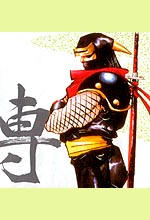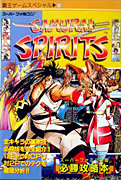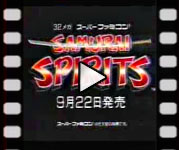SAMURAI SPIRITS
( Samurai Showdown )
|
|

|

|
|
サムライスピリッツ
©SNK 1993
Reprogrammed ©Takara Co.Ltd 1994
Release: 1994-09-22 (¥10900)
Cartridge SHVC-A7SJ
Fighting game


|
Released in America as
SAMURAI SHOWDOWN
( SNS-A7SE-USA )
|


|
Released in Europe as
SAMURAI SHOWDOWN
( SNSP-A7SP-XXX )
|
|
Samurai Spirits (aka Samuraï Shodown in the west) was first released for the
powerful Neo Geo console on a whooping 118 Mbits cartridge. Takara handled the
conversion for the Super Famicom system, only a year after its original release.
Samurai Spirits was probably one of the first fighting game to make significant use of
swords and other weapons in Japanese medieval times. The evil Amakusa is poised to take
over Japan, and no less than twelve fighters are on a desperate mission to stop him.
Each character has a complex background story, different personalities and, of course, special
moves. As aforementioned, weapons are what give Samurai Spirits its unique flavor. They
all greatly affect the game and it is important to learn how to correctly use them during fights
and how not to lose or drop them. Samurai Spirits also features a POWer meter. It
increases as the fighters receive damage and end up raising their overall attack power (like a sort of
an adrenaline rush). Three play modes are available : Arcade is a story mode where each
fight ends with a short animated cutscene, 2 Players gets two players to fight against
each other and, finally, a Time Attack mode. As a side note, this version was sadly heavily
censored, the blood option was highly reduced and finishing moves omitted.
|

|
Samurai Spirits was first released for SMK's Neo Geo system in 1993 on a whooping 118 Mbits cartridge.
It is interesting to notice that some characters are actually based on heroes
who really existed. For instance the evil Amakusa is most probably inspired
from the japanese priest Shiro Tokisada Amakusa who lived during the
17th century. And mighty ninja Hattori Hanzō (who's also featured in
the World Heroes series by Alpha Denshi Corp for SNK)
is most certainly based on the head of clan and ninja of the same name who
lived during the 16th century. The game gave rise to numerous sequels and
many players argue that Samurai Shodown II, released in 1994, is the
best of the series. All in all, five sequels were released in the arcades
and numerous versions appeared for a vast selection of home consoles including
Sega's Megadrive (1994), Sega's Game Gear (1994) and Nintendo's GameBoy (1994).
|
G
O
O
D
I
E
S
|
|

Japanese Book
|
|
|
O
M
A
K
E
|
|

|
|
|
Click on picture to enlarge |
|
|
|
LK

|
|
Add your Pov here !
|
P
O
V
s
|
|
I was a bit pessimistic at first, only the PC Engine system and the Arcade
Card managed to impress me in this field. Takara's task was certainly
challenging. However, Samurai Spirits is nervetheless a good conversion.
Despite the size of the character sprites (they shrunk by about a half),
the limited color palette, a rougher animation and the zoom effect removal,
Takara managed to keep a strong and intuitive gameplay. I should
also point out that there are some nasty slowdowns in a couple of places
in the game, but nothing bad. Also, most of the bloody effects are still
there, but are sort of tuned down. All in all, Samurai Spirits is
far to impress as much as its amazing model, but yet it manages to bring
a delightful conversion to the Super Famicom system.
|
|
|
|